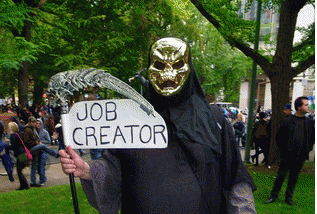With cunning and contempt and catechismal fervor the super-rich have argued that all money should move to the top, where it will be used to stimulate the economy and create jobs. But they ignore the facts that prove them wrong. And it doesn't take much to prove them wrong.
1. First, a look at the success of the super-rich: Money has quickly moved to the top
Based on IRS figures, the richest 1% nearly tripled its share of America's after-tax income from 1980 to 2006. That's an extra trillion dollars a year. Then, in the first year after the 2008 recession, they took 93% of all the new income.
Wealth is even more skewed. The richest 10% own 83% of financial wealth, which they've skillfully arranged to be taxed at just 15%, ostensibly because they pump that money back into job-creating ventures. More on that misconception later.
flickr image By badlyricpolice
Conservatives claim that wealth inequality has remained steady for the richest Americans. But data from Edward Wolff shows that the excess wealth was simply redistributed among the rest of the top 5%, who saw their share of America's net worth increase by 18 percent from 1983 to 2007. It was also noted by Sam Pizzigati that much of the top-level wealth was socked away tax-free overseas, a fact largely confirmed by a Tax Justice Network study.
2. Corporations are just as successful: profits have doubled, taxes cut in half
While corporate profits have doubled to $1.9 trillion in less than ten years, the corporate income tax rate, which for thirty years hovered around the 20-25% level, suddenly dropped to 10% after the recession. The biggest firms basically said "We're not paying."
That's a half-trillion dollars a year unpaid by the very companies who have successfully convinced much of America that their tax rates are too high.
The tax they actually pay is very low relative to other countries. U.S. corporations paid a smaller rate of income taxes than all but two of the OECD countries analyzed by the Office of Management and Budget and the Census Bureau. A Treasury report agreed, noting that the Tax/GDP rate for U.S. companies was 35% lower than the OECD average from 2000 to 2005.
Corporations even pay less than low-wage American workers. On their 2011 profits of $1.97 trillion, corporations paid $181 billion in federal income taxes (9%) and $40 billion in state income taxes (2%), for a total income tax burden of 11%. The poorest 20% of American citizens pay 17.4% in federal, state, and local taxes.
3. Some Non-Job-Creation Facts
The Wall Street Journal noted in 2009 that the Bush tax cuts led to the "worst track record for jobs in recorded history." 25 million people remain unemployed or underemployed, with 30 to 50 percent of recent college graduates in one of those categories. Among unemployed workers, nearly 43 percent have been without a job for six months or longer.
For the jobs that remain, most are low-paying, with the only real employment growth occurring in retail sales and food preparation. A recent report by the National Employment Law Project confirms that lower-wage occupations (up to about $14 per hour) accounted for 21 percent of recession losses and 58 percent of recovery growth, while mid-wage occupations (between $14 and $21 per hour) accounted for 60 percent of recession losses and only 22 percent of recovery growth.
The minimum wage is shamefully low, about 30% lower than the inflation-adjusted 1968 figure. And the tiny pay can't be blamed on small business. Two-thirds of America's low-wage workers, according to another National Employment Law Project report, work for companies that have at least 100 employees.
All these job woes persist while productivity has continued to grow, with an 80% increase since 1973 as median worker pay has stagnated.
4. So what are the "job creators" doing with all their money?
(Note: You can view every article as one long page if you sign up as an Advocate Member, or higher).






